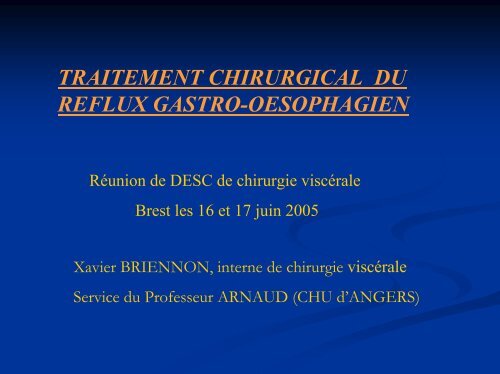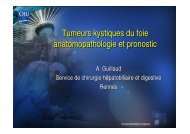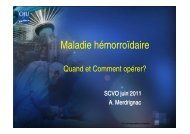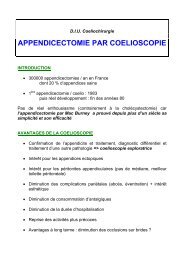diaporama - chirurgie viscérale de l'ouest
diaporama - chirurgie viscérale de l'ouest
diaporama - chirurgie viscérale de l'ouest
You also want an ePaper? Increase the reach of your titles
YUMPU automatically turns print PDFs into web optimized ePapers that Google loves.
TRAITEMENT CHIRURGICAL DU<br />
REFLUX GASTRO-OESOPHAGIEN<br />
Réunion <strong>de</strong> DESC <strong>de</strong> <strong>chirurgie</strong> <strong>viscérale</strong><br />
Brest les 16 et 17 juin 2005<br />
Xavier BRIENNON, interne <strong>de</strong> <strong>chirurgie</strong> <strong>viscérale</strong><br />
Service du Professeur ARNAUD (CHU d’ANGERS)
Pathologie très fréquente.<br />
INTRODUCTION<br />
Evolution possible vers <strong>de</strong> graves complications.<br />
Nombreuses techniques chirurgicales.<br />
Gran<strong>de</strong> place <strong>de</strong> la laparoscopie.
FACTEURS DE CONTINENCE<br />
GASTRO-OESOPHAGIENNE<br />
sphincter interne <strong>de</strong> l’œsophage (SIO)<br />
portion intra-abdominale <strong>de</strong> l’œsophage<br />
angle <strong>de</strong> HIS<br />
piliers du diaphragme<br />
membrane phréno-œsophagienne<br />
méso- œsophage<br />
musculature intrinsèque <strong>de</strong> l’œsophage
PRINCIPES DU TRAITEMENT<br />
CHIRURGICAL<br />
Restituer une anatomie normale:<br />
portion intra-abdominale <strong>de</strong> l’œsophage<br />
angle <strong>de</strong> His<br />
SIO par une valve<br />
Eviter un système valvulaire trop serré (stase œsophagienne).<br />
Eviter l’altération <strong>de</strong> la vidange gastrique par vagotomie.
PRINCIPALES TECHNIQUES<br />
Procédés <strong>de</strong> reposition anatomique:<br />
Procédés valvulaires:<br />
Interventions indirectes:<br />
-intervention <strong>de</strong> Lortat-Jacob<br />
-cardiopexie postérieure <strong>de</strong> Hill<br />
-intervention <strong>de</strong> Belsey<br />
-intervention <strong>de</strong> Nissen<br />
-intervention <strong>de</strong> Toupet<br />
-prothèse d’Angelchik<br />
-diversion duodénale totale <strong>de</strong> Holt et Large
DISSECTION DE L’HIATUS OESOPHAGIEN<br />
1-Incision du petit épiploon<br />
2-Incision du feuillet péritonéal du<br />
ligament phréno-œsophagien<br />
3-incision du ligament gastrophrénique
4-dissection <strong>de</strong> haut en bas du<br />
pilier droit jusqu’au pilier<br />
gauche<br />
5-œsophage récliné vers le<br />
bas permet la localisation du<br />
pilier gauche<br />
4<br />
5
6-dissection rétroœsophagienne:<br />
-méso-œsophage<br />
-partie postérieure<br />
du ligament gastrophrénique<br />
7-dissection <strong>de</strong> bas en<br />
haut du pilier gauche et<br />
repérage du nerf vague<br />
6<br />
7
8-section <strong>de</strong> la membrane<br />
phréno-œsophagienne<br />
9-dissection terminée <strong>de</strong><br />
l’hiatus œsophagien<br />
8<br />
9
INTERVENTION DE LORTAT-JACOB<br />
1-Fermeture <strong>de</strong>s piliers du<br />
diaphragme<br />
2-Fermeture <strong>de</strong> l’angle <strong>de</strong> His<br />
(fixation <strong>de</strong> la grosse tubérosité<br />
gastrique à l’œsophage)<br />
3-Fixation <strong>de</strong> la grosse tubérosité<br />
gastrique au diaphragme<br />
1<br />
3<br />
2
INTERVENTION DE HILL<br />
GASTROPEXIE POSTERIEURE<br />
1-Fermeture <strong>de</strong>s piliers du<br />
diaphragme 1 2<br />
2-Fixation <strong>de</strong>s feuillets ant. et<br />
post. <strong>de</strong> la petite courbure au<br />
ligament arqué
INTERVENTION DE BELSEY<br />
FUNDOPLICATURE<br />
PARTIELLE<br />
Voie thoracique<br />
Invagination <strong>de</strong> l’œsophage<br />
dans l’estomac<br />
Réintégration en sous<br />
diaphragmatique<br />
Fermeture <strong>de</strong>s piliers du<br />
diaphragme
1<br />
INTERVENTION DE NISSEN<br />
2<br />
3<br />
FUNDOPLICATURE COMPLETE<br />
1-Fermeture <strong>de</strong>s piliers du diaphragme<br />
2-Section <strong>de</strong>s vaisseaux courts<br />
3-Confection d’une valve<br />
<strong>de</strong> 360°<br />
<strong>de</strong> 5 à 8cm <strong>de</strong> hauteur<br />
solidarisée à l’œsophage
VARIANTES DE L’ INTERVENTION DE<br />
NISSEN<br />
NISSEN-ROSSETI:<br />
Floppy-NISSEN:<br />
Pas <strong>de</strong> section <strong>de</strong>s vaisseaux courts<br />
Valve <strong>de</strong> 2 à 3cm <strong>de</strong> hauteur<br />
Valve non solidarisée à l’œsophage<br />
Valve « lâche »<br />
Calibrage à la bougie
1<br />
INTERVENTION DE TOUPET<br />
3<br />
2<br />
FUNDOPLICATURE<br />
PARTIELLE DE 180°<br />
1-Fermeture <strong>de</strong>s piliers du diaphragme<br />
2-Fixation <strong>de</strong> la valve aux piliers<br />
3-Fixation <strong>de</strong> la valve aux bords droit et<br />
gauche <strong>de</strong> l’œsophage<br />
VARIANTE: fundoplicature partielle<br />
<strong>de</strong> 270°
PROTHESE D’ ANGELCHIK<br />
Fermeture <strong>de</strong>s piliers<br />
Elastomère <strong>de</strong> silicone<br />
Fermeture par lien <strong>de</strong> Dacron
DIVERSION DUODENALE TOTALE<br />
Vagotomie tronculaire bilatérale<br />
Antrectomie<br />
Anastomose gastro-jéjunale<br />
par anse en Y
TECHNIQUES ENDOSCOPIQUES<br />
1-TECHNIQUES DE<br />
SUTURE<br />
La cardioplicature
2-TECHNIQUES<br />
D’ INJECTION ET<br />
D’IMPLANTATION<br />
Technique du<br />
Gatekeeper system<br />
Endonetics®
3-TECHNIQUES PAR<br />
HYPERTHERMIE<br />
Radiofréquence selon le<br />
procédé <strong>de</strong> Stretta®
CONCLUSION<br />
Nombreuses techniques défendues par leurs auteurs.<br />
3 techniques principales: Nissen, Nissen-Rosseti et Toupet.<br />
A l’ère <strong>de</strong> la cœlioscopie, avantage aux techniques réalisable par<br />
cette voie d’abord.







